Academic and Professional Skills
VerifiedAdded on 2023/06/12
|7
|1948
|494
AI Summary
The article discusses the different approaches to learning and how they impact academic performance. It talks about deep and surface approaches to learning and achieving approach. It also highlights the importance of proper teaching to encourage a deeper approach towards learning accompanied by an achieving approach.
Contribute Materials
Your contribution can guide someone’s learning journey. Share your
documents today.
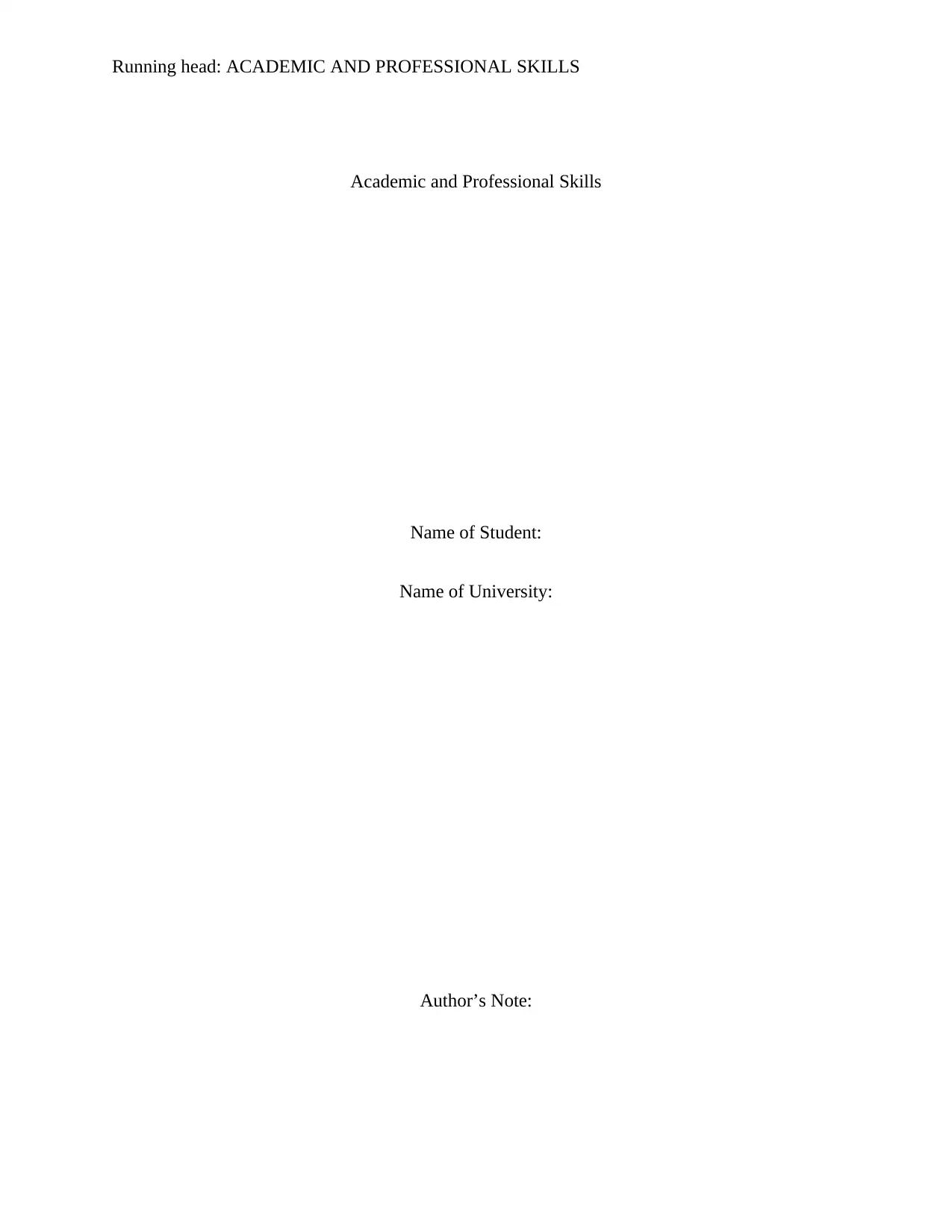
Running head: ACADEMIC AND PROFESSIONAL SKILLS
Academic and Professional Skills
Name of Student:
Name of University:
Author’s Note:
Academic and Professional Skills
Name of Student:
Name of University:
Author’s Note:
Secure Best Marks with AI Grader
Need help grading? Try our AI Grader for instant feedback on your assignments.

1ACADEMIC AND PROFESSIONAL SKILLS
The informed student centred teaching and also the learning practices cause the teachers
to reflect on the experiences, practices as well as the habits of study of the students. There have
been significant researchers on the topic of present innovations in the concept of learning. It
shows that the successful engagement with learning is concerned with the students dealing with
new requirements in the academic sphere. It is desired that the students need to be better thinkers
at the time of their proceedings through college. The surface approach to learning focuses on the
reproduction of information in order to meet the external demands of the class assessments
which is often seen to be followed by the students. The students who follow the surface
approaches to learning might also aim to meet the requirements in a minimalistic way and are
seen to be focussed on just fulfilling the basic requirements of the assessment rather than actually
learning.
One of the most important aspects of the college students in the first year is that of
learning. There is the need for the students to study within the stipulated time frame. This is
linked to the ideas and the concepts of study. No matter whichever sphere of study the students
are in there is the necessity for them to learn and understand those subject oriented concepts
thereby performing in class and also appearing and passing their stipulated examinations.
In case of learning strategies there is a focus on those pieces of information where
connections are made between the structures of what are being learnt by students in the class.
There is also a limit of their study to the bare essentials. There have also been cases where
students learn the things which they are to learn or reproduce by heart. There have also been
cases where there the students might have negative emotions about the ideas of learning. There
has been a key distinction between the deep and surface approaches to the concept of learning.
The informed student centred teaching and also the learning practices cause the teachers
to reflect on the experiences, practices as well as the habits of study of the students. There have
been significant researchers on the topic of present innovations in the concept of learning. It
shows that the successful engagement with learning is concerned with the students dealing with
new requirements in the academic sphere. It is desired that the students need to be better thinkers
at the time of their proceedings through college. The surface approach to learning focuses on the
reproduction of information in order to meet the external demands of the class assessments
which is often seen to be followed by the students. The students who follow the surface
approaches to learning might also aim to meet the requirements in a minimalistic way and are
seen to be focussed on just fulfilling the basic requirements of the assessment rather than actually
learning.
One of the most important aspects of the college students in the first year is that of
learning. There is the need for the students to study within the stipulated time frame. This is
linked to the ideas and the concepts of study. No matter whichever sphere of study the students
are in there is the necessity for them to learn and understand those subject oriented concepts
thereby performing in class and also appearing and passing their stipulated examinations.
In case of learning strategies there is a focus on those pieces of information where
connections are made between the structures of what are being learnt by students in the class.
There is also a limit of their study to the bare essentials. There have also been cases where
students learn the things which they are to learn or reproduce by heart. There have also been
cases where there the students might have negative emotions about the ideas of learning. There
has been a key distinction between the deep and surface approaches to the concept of learning.
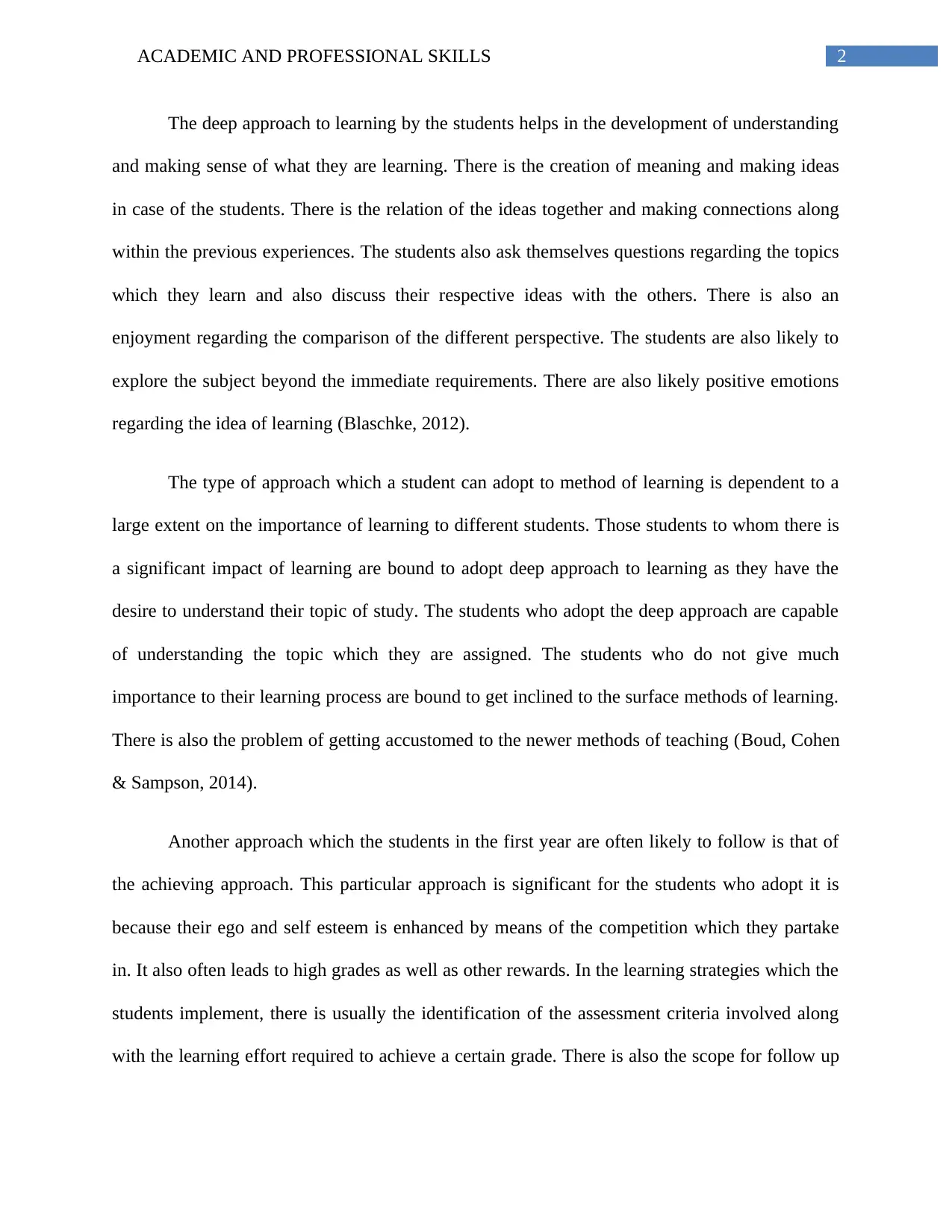
2ACADEMIC AND PROFESSIONAL SKILLS
The deep approach to learning by the students helps in the development of understanding
and making sense of what they are learning. There is the creation of meaning and making ideas
in case of the students. There is the relation of the ideas together and making connections along
within the previous experiences. The students also ask themselves questions regarding the topics
which they learn and also discuss their respective ideas with the others. There is also an
enjoyment regarding the comparison of the different perspective. The students are also likely to
explore the subject beyond the immediate requirements. There are also likely positive emotions
regarding the idea of learning (Blaschke, 2012).
The type of approach which a student can adopt to method of learning is dependent to a
large extent on the importance of learning to different students. Those students to whom there is
a significant impact of learning are bound to adopt deep approach to learning as they have the
desire to understand their topic of study. The students who adopt the deep approach are capable
of understanding the topic which they are assigned. The students who do not give much
importance to their learning process are bound to get inclined to the surface methods of learning.
There is also the problem of getting accustomed to the newer methods of teaching (Boud, Cohen
& Sampson, 2014).
Another approach which the students in the first year are often likely to follow is that of
the achieving approach. This particular approach is significant for the students who adopt it is
because their ego and self esteem is enhanced by means of the competition which they partake
in. It also often leads to high grades as well as other rewards. In the learning strategies which the
students implement, there is usually the identification of the assessment criteria involved along
with the learning effort required to achieve a certain grade. There is also the scope for follow up
The deep approach to learning by the students helps in the development of understanding
and making sense of what they are learning. There is the creation of meaning and making ideas
in case of the students. There is the relation of the ideas together and making connections along
within the previous experiences. The students also ask themselves questions regarding the topics
which they learn and also discuss their respective ideas with the others. There is also an
enjoyment regarding the comparison of the different perspective. The students are also likely to
explore the subject beyond the immediate requirements. There are also likely positive emotions
regarding the idea of learning (Blaschke, 2012).
The type of approach which a student can adopt to method of learning is dependent to a
large extent on the importance of learning to different students. Those students to whom there is
a significant impact of learning are bound to adopt deep approach to learning as they have the
desire to understand their topic of study. The students who adopt the deep approach are capable
of understanding the topic which they are assigned. The students who do not give much
importance to their learning process are bound to get inclined to the surface methods of learning.
There is also the problem of getting accustomed to the newer methods of teaching (Boud, Cohen
& Sampson, 2014).
Another approach which the students in the first year are often likely to follow is that of
the achieving approach. This particular approach is significant for the students who adopt it is
because their ego and self esteem is enhanced by means of the competition which they partake
in. It also often leads to high grades as well as other rewards. In the learning strategies which the
students implement, there is usually the identification of the assessment criteria involved along
with the learning effort required to achieve a certain grade. There is also the scope for follow up
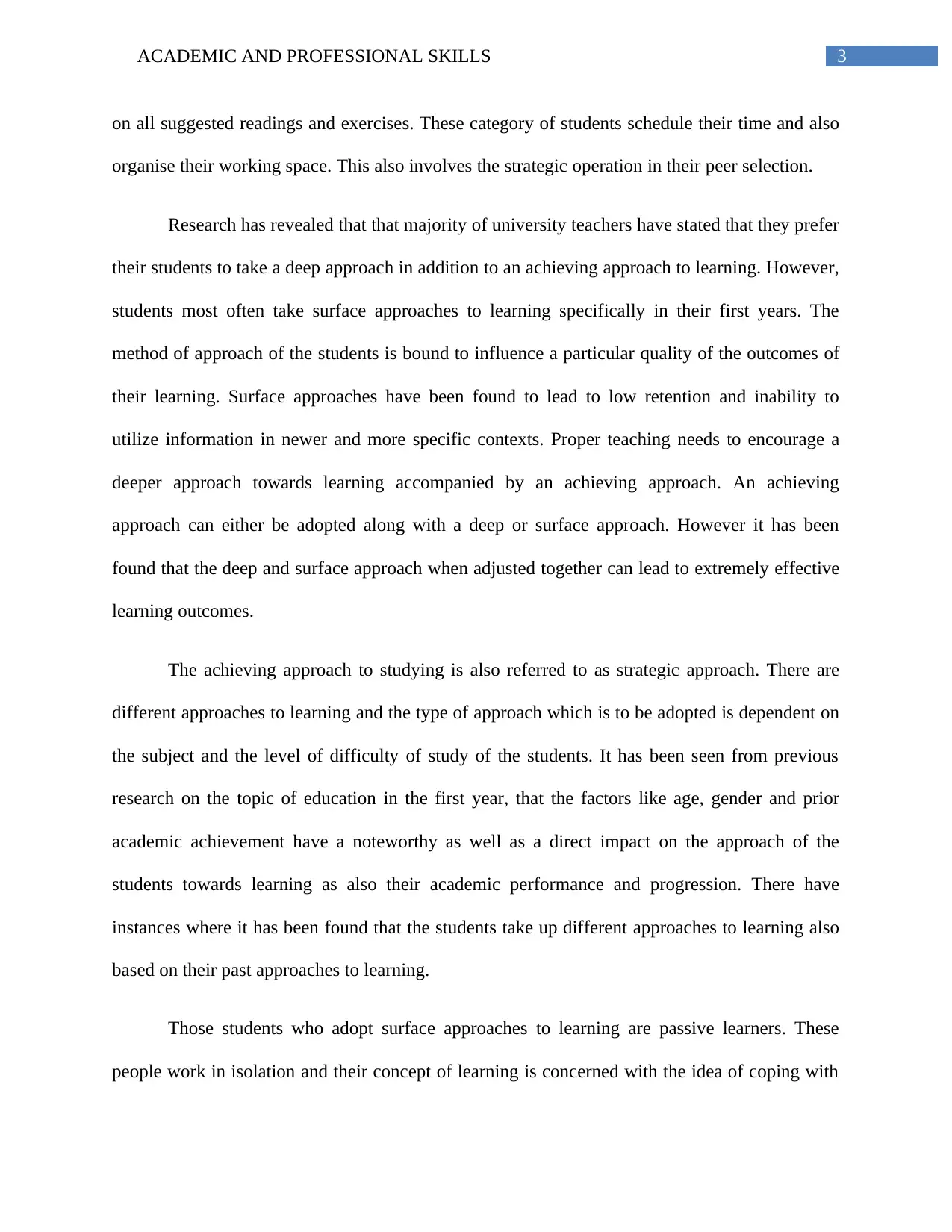
3ACADEMIC AND PROFESSIONAL SKILLS
on all suggested readings and exercises. These category of students schedule their time and also
organise their working space. This also involves the strategic operation in their peer selection.
Research has revealed that that majority of university teachers have stated that they prefer
their students to take a deep approach in addition to an achieving approach to learning. However,
students most often take surface approaches to learning specifically in their first years. The
method of approach of the students is bound to influence a particular quality of the outcomes of
their learning. Surface approaches have been found to lead to low retention and inability to
utilize information in newer and more specific contexts. Proper teaching needs to encourage a
deeper approach towards learning accompanied by an achieving approach. An achieving
approach can either be adopted along with a deep or surface approach. However it has been
found that the deep and surface approach when adjusted together can lead to extremely effective
learning outcomes.
The achieving approach to studying is also referred to as strategic approach. There are
different approaches to learning and the type of approach which is to be adopted is dependent on
the subject and the level of difficulty of study of the students. It has been seen from previous
research on the topic of education in the first year, that the factors like age, gender and prior
academic achievement have a noteworthy as well as a direct impact on the approach of the
students towards learning as also their academic performance and progression. There have
instances where it has been found that the students take up different approaches to learning also
based on their past approaches to learning.
Those students who adopt surface approaches to learning are passive learners. These
people work in isolation and their concept of learning is concerned with the idea of coping with
on all suggested readings and exercises. These category of students schedule their time and also
organise their working space. This also involves the strategic operation in their peer selection.
Research has revealed that that majority of university teachers have stated that they prefer
their students to take a deep approach in addition to an achieving approach to learning. However,
students most often take surface approaches to learning specifically in their first years. The
method of approach of the students is bound to influence a particular quality of the outcomes of
their learning. Surface approaches have been found to lead to low retention and inability to
utilize information in newer and more specific contexts. Proper teaching needs to encourage a
deeper approach towards learning accompanied by an achieving approach. An achieving
approach can either be adopted along with a deep or surface approach. However it has been
found that the deep and surface approach when adjusted together can lead to extremely effective
learning outcomes.
The achieving approach to studying is also referred to as strategic approach. There are
different approaches to learning and the type of approach which is to be adopted is dependent on
the subject and the level of difficulty of study of the students. It has been seen from previous
research on the topic of education in the first year, that the factors like age, gender and prior
academic achievement have a noteworthy as well as a direct impact on the approach of the
students towards learning as also their academic performance and progression. There have
instances where it has been found that the students take up different approaches to learning also
based on their past approaches to learning.
Those students who adopt surface approaches to learning are passive learners. These
people work in isolation and their concept of learning is concerned with the idea of coping with
Secure Best Marks with AI Grader
Need help grading? Try our AI Grader for instant feedback on your assignments.
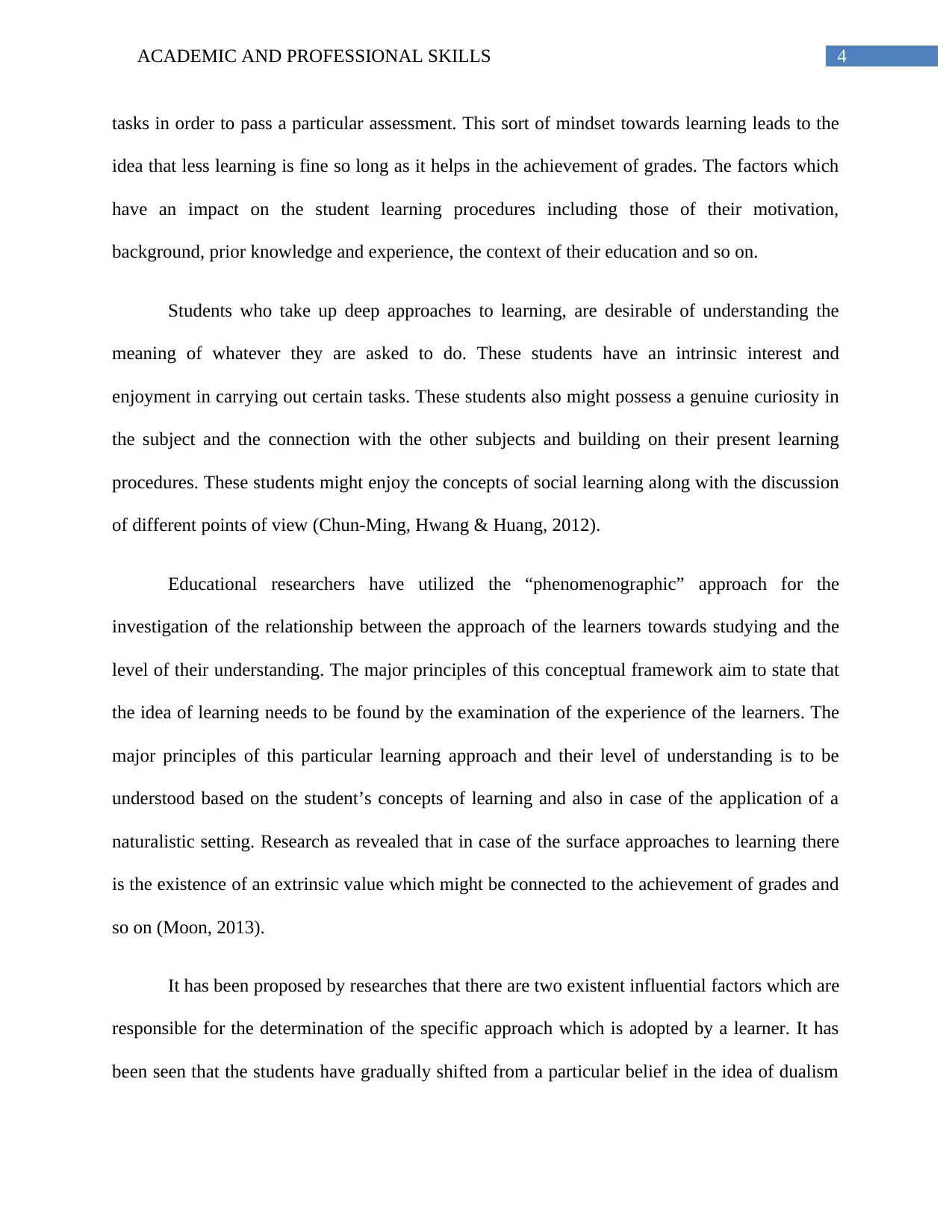
4ACADEMIC AND PROFESSIONAL SKILLS
tasks in order to pass a particular assessment. This sort of mindset towards learning leads to the
idea that less learning is fine so long as it helps in the achievement of grades. The factors which
have an impact on the student learning procedures including those of their motivation,
background, prior knowledge and experience, the context of their education and so on.
Students who take up deep approaches to learning, are desirable of understanding the
meaning of whatever they are asked to do. These students have an intrinsic interest and
enjoyment in carrying out certain tasks. These students also might possess a genuine curiosity in
the subject and the connection with the other subjects and building on their present learning
procedures. These students might enjoy the concepts of social learning along with the discussion
of different points of view (Chun-Ming, Hwang & Huang, 2012).
Educational researchers have utilized the “phenomenographic” approach for the
investigation of the relationship between the approach of the learners towards studying and the
level of their understanding. The major principles of this conceptual framework aim to state that
the idea of learning needs to be found by the examination of the experience of the learners. The
major principles of this particular learning approach and their level of understanding is to be
understood based on the student’s concepts of learning and also in case of the application of a
naturalistic setting. Research as revealed that in case of the surface approaches to learning there
is the existence of an extrinsic value which might be connected to the achievement of grades and
so on (Moon, 2013).
It has been proposed by researches that there are two existent influential factors which are
responsible for the determination of the specific approach which is adopted by a learner. It has
been seen that the students have gradually shifted from a particular belief in the idea of dualism
tasks in order to pass a particular assessment. This sort of mindset towards learning leads to the
idea that less learning is fine so long as it helps in the achievement of grades. The factors which
have an impact on the student learning procedures including those of their motivation,
background, prior knowledge and experience, the context of their education and so on.
Students who take up deep approaches to learning, are desirable of understanding the
meaning of whatever they are asked to do. These students have an intrinsic interest and
enjoyment in carrying out certain tasks. These students also might possess a genuine curiosity in
the subject and the connection with the other subjects and building on their present learning
procedures. These students might enjoy the concepts of social learning along with the discussion
of different points of view (Chun-Ming, Hwang & Huang, 2012).
Educational researchers have utilized the “phenomenographic” approach for the
investigation of the relationship between the approach of the learners towards studying and the
level of their understanding. The major principles of this conceptual framework aim to state that
the idea of learning needs to be found by the examination of the experience of the learners. The
major principles of this particular learning approach and their level of understanding is to be
understood based on the student’s concepts of learning and also in case of the application of a
naturalistic setting. Research as revealed that in case of the surface approaches to learning there
is the existence of an extrinsic value which might be connected to the achievement of grades and
so on (Moon, 2013).
It has been proposed by researches that there are two existent influential factors which are
responsible for the determination of the specific approach which is adopted by a learner. It has
been seen that the students have gradually shifted from a particular belief in the idea of dualism
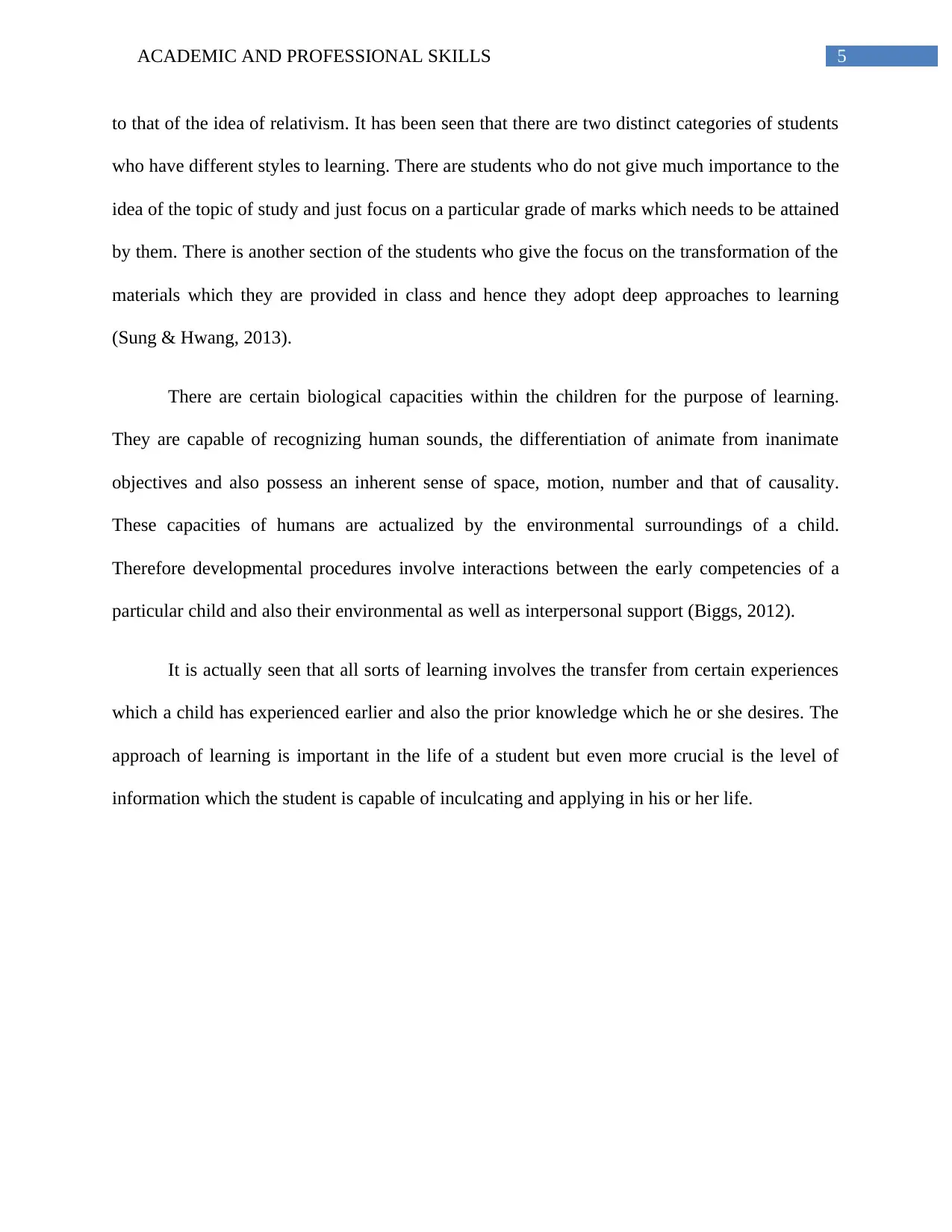
5ACADEMIC AND PROFESSIONAL SKILLS
to that of the idea of relativism. It has been seen that there are two distinct categories of students
who have different styles to learning. There are students who do not give much importance to the
idea of the topic of study and just focus on a particular grade of marks which needs to be attained
by them. There is another section of the students who give the focus on the transformation of the
materials which they are provided in class and hence they adopt deep approaches to learning
(Sung & Hwang, 2013).
There are certain biological capacities within the children for the purpose of learning.
They are capable of recognizing human sounds, the differentiation of animate from inanimate
objectives and also possess an inherent sense of space, motion, number and that of causality.
These capacities of humans are actualized by the environmental surroundings of a child.
Therefore developmental procedures involve interactions between the early competencies of a
particular child and also their environmental as well as interpersonal support (Biggs, 2012).
It is actually seen that all sorts of learning involves the transfer from certain experiences
which a child has experienced earlier and also the prior knowledge which he or she desires. The
approach of learning is important in the life of a student but even more crucial is the level of
information which the student is capable of inculcating and applying in his or her life.
to that of the idea of relativism. It has been seen that there are two distinct categories of students
who have different styles to learning. There are students who do not give much importance to the
idea of the topic of study and just focus on a particular grade of marks which needs to be attained
by them. There is another section of the students who give the focus on the transformation of the
materials which they are provided in class and hence they adopt deep approaches to learning
(Sung & Hwang, 2013).
There are certain biological capacities within the children for the purpose of learning.
They are capable of recognizing human sounds, the differentiation of animate from inanimate
objectives and also possess an inherent sense of space, motion, number and that of causality.
These capacities of humans are actualized by the environmental surroundings of a child.
Therefore developmental procedures involve interactions between the early competencies of a
particular child and also their environmental as well as interpersonal support (Biggs, 2012).
It is actually seen that all sorts of learning involves the transfer from certain experiences
which a child has experienced earlier and also the prior knowledge which he or she desires. The
approach of learning is important in the life of a student but even more crucial is the level of
information which the student is capable of inculcating and applying in his or her life.
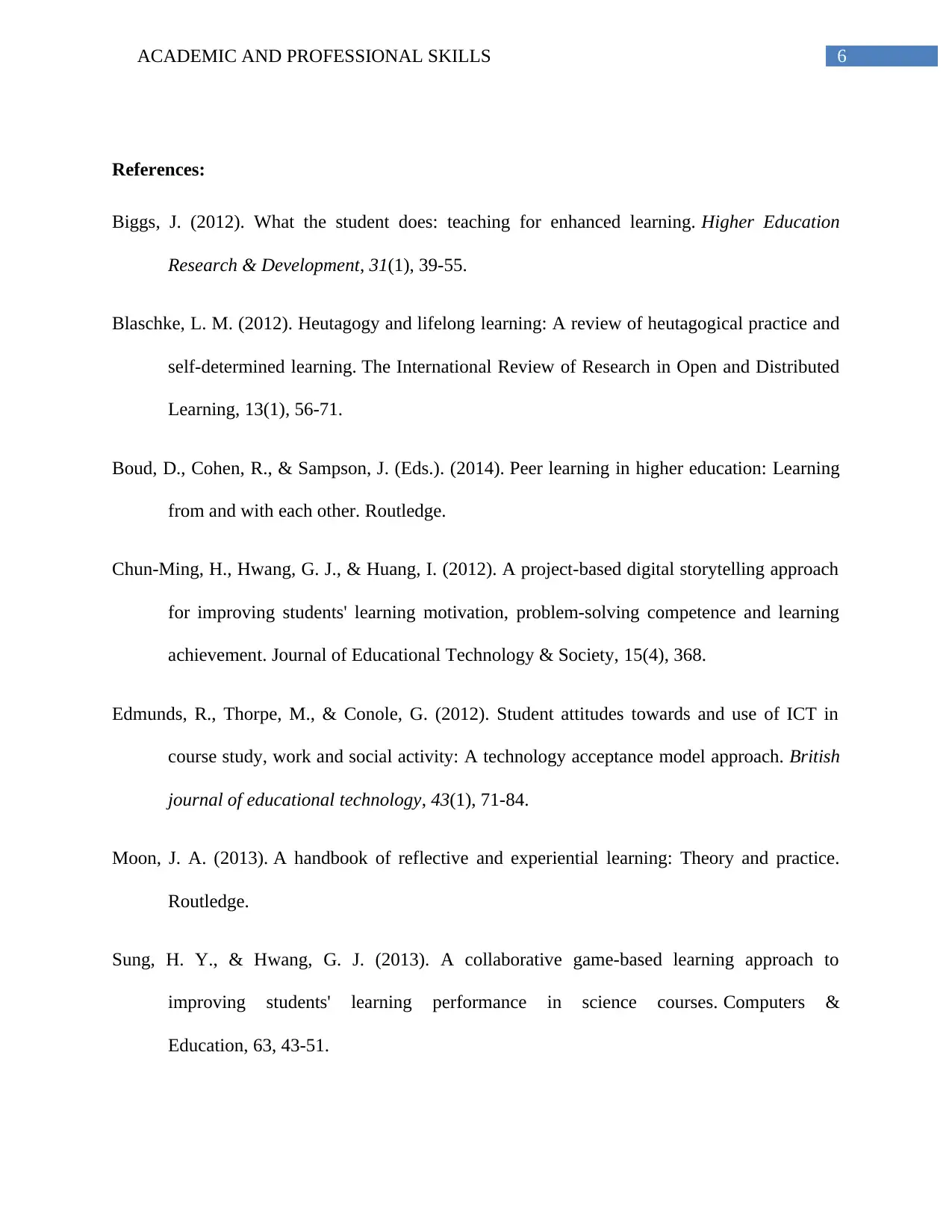
6ACADEMIC AND PROFESSIONAL SKILLS
References:
Biggs, J. (2012). What the student does: teaching for enhanced learning. Higher Education
Research & Development, 31(1), 39-55.
Blaschke, L. M. (2012). Heutagogy and lifelong learning: A review of heutagogical practice and
self-determined learning. The International Review of Research in Open and Distributed
Learning, 13(1), 56-71.
Boud, D., Cohen, R., & Sampson, J. (Eds.). (2014). Peer learning in higher education: Learning
from and with each other. Routledge.
Chun-Ming, H., Hwang, G. J., & Huang, I. (2012). A project-based digital storytelling approach
for improving students' learning motivation, problem-solving competence and learning
achievement. Journal of Educational Technology & Society, 15(4), 368.
Edmunds, R., Thorpe, M., & Conole, G. (2012). Student attitudes towards and use of ICT in
course study, work and social activity: A technology acceptance model approach. British
journal of educational technology, 43(1), 71-84.
Moon, J. A. (2013). A handbook of reflective and experiential learning: Theory and practice.
Routledge.
Sung, H. Y., & Hwang, G. J. (2013). A collaborative game-based learning approach to
improving students' learning performance in science courses. Computers &
Education, 63, 43-51.
References:
Biggs, J. (2012). What the student does: teaching for enhanced learning. Higher Education
Research & Development, 31(1), 39-55.
Blaschke, L. M. (2012). Heutagogy and lifelong learning: A review of heutagogical practice and
self-determined learning. The International Review of Research in Open and Distributed
Learning, 13(1), 56-71.
Boud, D., Cohen, R., & Sampson, J. (Eds.). (2014). Peer learning in higher education: Learning
from and with each other. Routledge.
Chun-Ming, H., Hwang, G. J., & Huang, I. (2012). A project-based digital storytelling approach
for improving students' learning motivation, problem-solving competence and learning
achievement. Journal of Educational Technology & Society, 15(4), 368.
Edmunds, R., Thorpe, M., & Conole, G. (2012). Student attitudes towards and use of ICT in
course study, work and social activity: A technology acceptance model approach. British
journal of educational technology, 43(1), 71-84.
Moon, J. A. (2013). A handbook of reflective and experiential learning: Theory and practice.
Routledge.
Sung, H. Y., & Hwang, G. J. (2013). A collaborative game-based learning approach to
improving students' learning performance in science courses. Computers &
Education, 63, 43-51.
1 out of 7
Related Documents
Your All-in-One AI-Powered Toolkit for Academic Success.
+13062052269
info@desklib.com
Available 24*7 on WhatsApp / Email
![[object Object]](/_next/static/media/star-bottom.7253800d.svg)
Unlock your academic potential
© 2024 | Zucol Services PVT LTD | All rights reserved.




